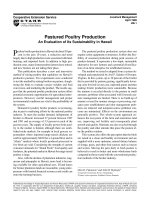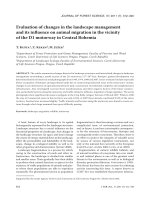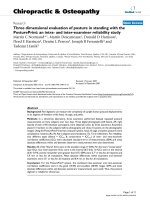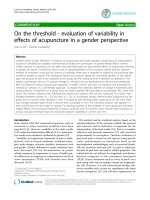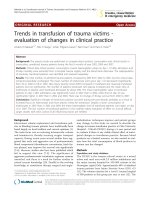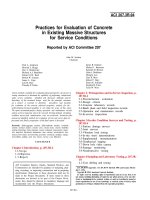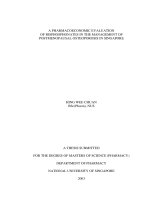Evaluation of MAK all season horticultural mineral oil (HMO) against major insect pests of apple in Kashmir
Bạn đang xem bản rút gọn của tài liệu. Xem và tải ngay bản đầy đủ của tài liệu tại đây (384.94 KB, 9 trang )
Int.J.Curr.Microbiol.App.Sci (2018) 7(11): 1270-1278
International Journal of Current Microbiology and Applied Sciences
ISSN: 2319-7706 Volume 7 Number 11 (2018)
Journal homepage:
Original Research Article
/>
Evaluation of MAK All Season Horticultural Mineral Oil (HMO) Against
Major Insect Pests of Apple in Kashmir
Asma Sherwani, Malik Mukhtar*, Parveena Bano and Saima Maqsood
Division of Entomology, Sher-e-Kashmir University of Agricultural Sciences and Technology
of Kashmir, Shalimar Srinagar, India
*Corresponding author
ABSTRACT
Keywords
Apple, San Jose scale,
European red mite, Bio
efficacy
Article Info
Accepted:
10 October 2018
Available Online:
10 November 2018
Field evaluation of MAK all season Horticultural Mineral Oil (HMO) was done against
San Jose scale Quadraspidiotus perniciosus Comstock and European red mite Panonychus
ulmi Koch in apple orchards at two locations in Kashmir under field conditions during year
2014-2015. Phytotoxicity and effect on natural enemies were also recorded. HP (HMO)
was used as standard check for conducting the experiment. Both the oils were sprayed
during dormant and summer season to suppress different stages of the insect pests.
Different concentrations of oil were sprayed viz., 2.5, 2.0 and 1.5% during dormant season
and 1.0, 0.75 and 0.50% in summer season. All the concentrations significantly reduced
the pest population over the standard check. Highest mortality of 76.66% and 81.22% were
recorded against San Jose scale and 78.19% and 82.35 % against European red mite at
2.5% at Wakura during dormant and summer season respectively. None of the
phytotoxicity effects were seen on the apple plant. Stethorus punctum and Coccinellids
were the key predators found feeding on scale insect and European red mite. Maximum
cumulative mean mortality of natural enemies was recorded as 36.73 at 1.0 % spray of
MAK. The findings of the study exerted that by spraying these oils considerable reduction
in the rate of infestation was observed in apple trees at both the locations.
Introduction
In Jammu and Kashmir, apple Malus
domestica (Borkh) is the most important fruit
crop among all the cultivated fruits. However,
the production and quality of apple is affected
because of several factors including insect
pests. The major insect pests attacking this
crop are San Jose scale and European red mite
and are the most destructive and widely
distributed all over the world (Bhalla and
Gupta 1993). These pests have been
accidentally introduced to many countries and
are considered major pests in most regions of
the world where deciduous fruits are grown
(Madson and Morgan, 1970). The damage by
San Jose scale Quadraspidiotus perniciosus
(Comstock) is caused by nymphs and female
scales, which suck the sap from branches,
twigs and fruits, weakens the plant and leaves,
render
the
fruit
unacceptable
and
unmarketable.
European
Red
Mite
Panonychus ulmi (Koch) is another serious
pest feeding on foliage and thereby reducing
1270
Int.J.Curr.Microbiol.App.Sci (2018) 7(11): 1270-1278
the yield of the plant. Different HMO’s have
been tested for the control of San Jose scale
(Badenes et al., 2010), while as insecticides
have also been used for the management of
San Jose scale (Singh et al., 2001). Taking a
note of the severity of the pests the experiment
was undertaken to test the efficacy of the
product, its phytotoxicity, and impact on
quality apple yield and effect on natural
enemies in the apple ecosystem of Kashmir
Valley.
Materials and Methods
To evaluate the effectiveness of MAK
Horticultural mineral oil against San Jose
scale and European red mite on apple, field
trial was carried out in an apple orchard in
Wakura and Zaznah of Ganderbal district
during 2014-15 and 2015-16 in Kashmir in a
randomized block design (RBD). The orchard
had apple trees of Red Delicious cultivar
having uniform size and age of 20 years. The
orchard was selected taking into account the
outbreak and damage caused by the pest.
There were seven treatments and each
treatment was replicated thrice. Three
treatments of MAK all season HMO @ 1.5,
2.0 and 2.5% were compared with that of
Standard Check (HP HMO) @ 1.5, 2.0 and
2.5% in dormant and three treatments of MAK
all season HMO @ 0.5, 0.75 and 1.0% were
compared with three treatments of Standard
Check (HP HMO) @ 0.5, 0.75 and 1.0 % in
summer. Water Sprayed Trees were kept as
untreated control. Spraying was done by high
volume power sprayer @10 liter / tree in
Dormant and @ 15 liter/tree in summer. Pre–
treatment observations were recorded before
the spray and post treatment observations were
recorded after 1, 3, 7, 15 and 30 days after
spray for the population of San Jose scale and
European red mite.
The observations on San Jose scale were
recorded from 12 twigs /tree from different
directions. 1cm2 area (bottom, middle and top)
was marked on each twig. The number of
crawlers of San Jose scale in dormant, females
and nymphs in summer were recorded from
each twig. In case of European Red Mite 12
twigs/ tree, each twig 10 cm long were marked
for recording the eggs of ERM in dormant
season, while as in summer 20 leaves/ tree
were taken for observation, both adult and
immature stages of ERM were recorded. Bio
efficacy and phytotoxicity observations were
also recorded after spray in summer at both
the locations. Phytotoxicity data as leaf injury
on tips/surface, yellowing, wilting, necrosis,
hyponasty and epinasty were recorded after
3,7,15 and 30 days after spray using(1-10)
scale. Yield was calculated on the basis of A
grade apple boxes / tree treatment wise at
harvesting time. Similarly the observations on
natural enemies were also recorded one day
before treatment and 1, 5, 7 and 10 days after
treatment for each replication. Mortality of all
the insect pests was subjected to corrected per
cent mortality as per Abbott 1925. The
findings of the study are depicted in Table 1-5
in results.
Results and Discussion
Bio efficacy
San Jose scale (Dormant season 2014 and
2015)
The results presented in table 1 indicated that
all the oil treatments were better than the
untreated control. Observed data revealed that
at Wakura pooled mean mortality of 73.30 per
cent was recorded in MAK all season HMO @
2.5 per cent, followed by 68.83 per cent @ 2.0
per cent and 62.03 per cent @ 1.5 per cent.
Standard Check (HP HMO) recorded highest
mean mortality of 76.66 per cent @ 2.5 per
cent, followed by 68.65 per cent @ 2 per cent
and 60.04 per cent @ 1.5 per cent,
respectively. Water sprayed plants (untreated
1271
Int.J.Curr.Microbiol.App.Sci (2018) 7(11): 1270-1278
control) recorded the lowest pooled mean
mortality of 11.89 per cent. In Zaznah pooled
mean mortality of 75.11 per cent was recorded
in MAK all season HMO @ 2.5 per cent,
followed by 71.01 per cent @ 2 per cent and
62.48 per cent @ 1.5 per cent, respectively.
Standard Check (HP HMO) recorded highest
cumulative mean mortality of 75.93 per cent
@ 2.5 per cent, followed by 69.01 per cent @
2 per cent and 59.32 per cent @ 1.5 per cent,
respectively. Water sprayed plants (untreated
control) recorded the lowest pooled mean
mortality of 9.75 per cent. All the treatments
were significantly different from untreated
control, whereas the treatments of MAK all
season HMO @ 1.5, 2.0 and 2.5 per cent were
statistically at par with Standard Check (HP
HMO) @ 1.5, 2.0 and 2.5 per cent when tested
at P=0.05 at 30 days after application of
treatment. Among the treatments of MAK all
season HMO and Standard Check (HP HMO)
@ 2.0 and 2.5 percent were at par with each
other when tested at P=0.05 at 30 days after
application of treatment.
San Jose scale (Summer 2014 and 2015)
Perusal of the data in Table 2 revealed that at
Wakura highest pooled mean mortality of
78.95 per cent was recorded in MAK all
season HMO @ 1.0 per cent, followed by
72.71 per cent @ 0.75 per cent and 62.90 per
cent @ 0.50 per cent. Standard Check (HP
HMO) recorded highest cumulative mean
mortality of 81.22 per cent @1.0 per cent,
followed by 74.99 per cent @ 0.75 per cent
and 66.49 per cent @ 0.50 per cent,
respectively. Water sprayed plants (untreated
control) recorded the lowest cumulative mean
mortality of 12.93 per cent. In Zaznah pooled
mean mortality of 80.94 per cent was recorded
in MAK all season HMO @ 1.0 per cent,
followed by 72.69 per cent @ 0.75 per cent
and 59.48 per cent @ 0.5 per cent,
respectively. Standard Check (HP HMO)
recorded highest cumulative mean mortality of
77.74 per cent @1.0 per cent, followed by
75.86 per cent @ 0.75 per cent and 65.77 per
cent @ 0.5 per cent, respectively. Water
sprayed plants (untreated control) recorded the
lowest pooled mean mortality of 14.16 per
cent. All the treatments were significantly
different from untreated control, whereas the
treatments of MAK all season HMO @ 0.50,
0.75and 1.0 per cent were statistically at par
with Standard Check (HP HMO) @ 0.50,
0.75and 1.0 per cent when tested at P=0.05 at
30 days after application of treatment.
European red mite (Dormant 2014 and
2015)
The results presented in table 3 indicated that
all the oil treatments were better than the
untreated control. Data recorded revealed that
at Wakura pooled mean mortality of 75.52 per
cent was recorded in MAK all season HMO @
2.5 per cent, followed by 72.22 per cent @ 2.0
per cent and 64.13 per cent @ 1.5 per cent.
Standard Check (HP HMO) recorded highest
cumulative mean mortality of 78.19 per cent
@ 2.5 per cent, followed by 73.03 per cent @
2 per cent and 65.56 per cent @ 1.5 per cent,
respectively. Water sprayed plants (untreated
control) recorded the lowest pooled mean
mortality of 8.26 per cent. In Zaznah pooled
mean mortality of 75.11 per cent was recorded
in MAK all season HMO @ 2.5 per cent,
followed by 71.58 per cent @ 2 per cent and
62.77 per cent @ 1.5 per cent, respectively.
Standard Check (HP HMO) recorded highest
cumulative mean mortality of 76.64 per cent
@ 2.5 per cent, followed by 73.70 per cent @
2 per cent and 65.58 per cent @ 1.5 per cent,
respectively. Water sprayed plants (untreated
control) recorded the lowest pooled mean
mortality of 8.15 per cent. All the treatments
were significantly different from untreated
control, whereas the treatments of MAK all
season HMO @ 1.5, 2.0 and 2.5 per cent were
statistically at par with Standard Check (HP
HMO) @ 1.5, 2.0 and 2.5 per cent when tested
1272
Int.J.Curr.Microbiol.App.Sci (2018) 7(11): 1270-1278
at P=0.05 at 30 days after application of
treatment. Among the treatments of MAK all
season HMO and Standard Check (HP HMO)
@ 2.0 and 2.5 percent were at par with each
other when tested at P=0.05 at 30 days after
application of treatment.
European red mite (Summer 2014 and
2015)
Perusal of the data in Table 4 revealed that at
Wakura highest pooled mean mortality of
83.19 per cent was recorded in MAK all
season HMO @ 1.0 per cent, followed by
77.94 per cent @ 0.75 per cent and 74.99 per
cent @ 0.50 per cent. Standard Check (HP
HMO) recorded highest cumulative mean
mortality of 82.35 per cent @1.0 per cent,
followed by 77.81 per cent @ 0.75 per cent
and 73.73 per cent @ 0.50 per cent,
respectively. Water sprayed plants (untreated
control) recorded the lowest cumulative mean
mortality of 12.19 per cent. In Zaznah pooled
mean mortality of 81.52 per cent was recorded
in MAK all season HMO @ 1.0 per cent,
followed by 73.97 per cent @ 0.75 per cent
and 71.42 per cent @ 0.5 per cent,
respectively. Standard Check (HP HMO)
recorded highest cumulative mean mortality of
79.11 per cent @ 1.0 per cent, followed by
78.28 per cent @ 0.75 per cent and 69.13 per
cent @ 0.5 per cent, respectively. Water
sprayed plants (untreated control) recorded the
lowest pooled mean mortality of 11.92 per
cent. All the treatments were significantly
different from untreated control, whereas the
treatments of MAK all season HMO @ 0.50,
0.75and 1.0 per cent were statistically at par
with Standard Check (HP HMO) @ 0.50,
0.75and 1.0 per cent when tested at P=0.05 at
30 days after application of treatment.
Phytotoxicity on apple plants
The test dosages of MAK all season HMO
were sprayed with three concentrations in
summer as 0.50, 0.75 and 1.0 for phytotoxicity
study. The phytotoxicity observations were
recorded on 3, 7, 15 and 30 days after spray.
Observations were recorded as leaf injury,
yellowing, wilting, necrosis, hyponasty and
epinasty. No adverse effect on apple trees after
spray was recorded and there were no
phytotoxicity symptoms recorded during the
evaluation programme in both the years 2014
and 2015 at both the locations Wakura and
Zaznah District Ganderbal Kashmir (J&K).
Toxicity to Natural Enemies
Wakura
Toxicity of MAK all season HMO was
evaluated against two important natural
enemies Stethorus punctum and Coccinellids
associated with San Jose scale and European
red mite in the Kashmir Valley as presented in
table 5. Highest cumulative mean mortality of
natural enemies was recorded as 36.73 % in
case of MAK all season HMO @ 1% followed
by 31.15 % @ 0.75% and 21.42 % @ 0.50 %
respectively. While as Standard Check (HP
HMO) recorded highest cumulative mean
mortality of 27.05% @ 1 % followed by 24.61
% @ 0.75 % and 18.12% @ 0.50%. Highest
pooled mean mortality of 36.46 % of
Stethorus punctum was recorded in MAK all
season HMO @ 1% followed by 32.29 % @
0.75 % and 18.44 % @ 0.5 %. The pooled
mean mortality of 27.07 % of Stethorus
punctum was recorded in Standard Check (HP
HMO) @ 1% followed by 23.69 % @ 0.75 %
and 18.05 % @ 0.5 % respectively. Perusal of
data in table 5 revealed that Highest pooled
mean mortality of 37.00 % of Coccinellids
was recorded in MAK all season HMO @ 1%
followed by 30.00 % @ 0.75 % and 24.41 %
@ 0.5 %. The pooled mean mortality of 27.04
% of Coccinellids was recorded in Standard
Check (HP HMO) @ 1% followed by 23.87 %
@ 0.75 % and 18.20 % @ 0.5 % respectively.
1273
Int.J.Curr.Microbiol.App.Sci (2018) 7(11): 1270-1278
Table.1 Bioefficacy of MAK all season HMO as dormant spray against San Jose Scale
Quadraspidiotus perniciosus on apple cv. Red Delicious at Wakura and Zaznah (District
Ganderbal) Kashmir (J&K) during 2014 and 2015
Wakura
Treatment
HMO (MAK)
HMO (HP) Check
Control
C.D (0.05)
HMO (MAK)
HMO (HP) Check
Control
C.D (0.05)
Conc. %
Pre-treatment
count/cm2
1.5
2.0
2.5
1.5
2.0
2.5
-
34.00
33.83
31.15
31.00
30.00
30.62
31.09
1.5
2.0
2.5
1.5
2.0
2.5
-
38.53
39.54
37.39
37.39
38.09
38.29
37.84
Per cent corrected mortality of San Jose Scale/cm2
(DAT)
1
3
7
15
30
27.33
49.96
64.32
81.04
87.50
47.67
54.46
65.40
84.77
91.87
48.53
60.31
73.35
89.20
95.14
28.67
39.42
60.26
82.92
88.94
38.36
54.76
71.13
85.45
93.55
51.22
65.24
80.05
90.39
96.38
3.59
8.62
13.23
15.75
18.27
1.11
1.58
1.17
1.04
0.99
Zaznah
27.71
47.11
65.17
83.20
89.20
47.01
58.29
69.03
87.35
93.37
48.67
63.24
76.68
91.11
95.83
28.23
37.10
59.79
82.74
88.74
40.73
56.05
69.31
85.48
93.47
49.12
64.55
78.97
90.86
96.14
4.00
7.61
10.22
11.54
15.39
1.02
1.00
0.89
0.75
1.05
Pooled
Mean
*Yield (A grade
apple)
62.03
68.83
73.30
60.04
68.65
76.66
11.89
4.20
4.89
5.52
4.29
4.65
5.10
3.18
62.48
71.01
75.11
59.32
69.01
75.93
9.75
4.25
4.30
5.30
4.38
4.80
5.85
3.17
DAT= Days after treatment
*= Boxes/tree
Table.2 Bioefficacy of MAK all season HMO as summer spray against San Jose Scale
Quadraspidiotus perniciosus on apple cv. Red Delicious at Wakura and Zaznah (District
Ganderbal) Kashmir (J&K) during 2014 and 2015
Wakura
Treatment
HMO (MAK)
HMO (HP) Check
Control
C.D (0.05)
HMO (MAK)
HMO (HP) Check
Control
C.D (0.05)
Conc. %
0.50
0.75
1.0
0.50
0.75
1.0
-
0.50
0.75
1.0
0.50
0.75
1.0
-
Pre-treatment
count/cm2
8.65
9.04
8.89
9.07
9.52
9.34
9.62
7.42
8.77
9.85
8.80
9.40
8.54
9.75
Per cent corrected mortality of San Jose
Scale/cm2
(DAT)
1
3
7
15
30
22.87
49.54
71.39
84.29
86.43
47.42
63.95
78.55
86.31
88.35
60.22
73.16
84.18
86.79
90.39
33.28
47.59
73.14
81.42
87.42
50.01
59.01
79.82
84.90
89.12
66.34
69.72
83.83
87.62
91.42
7.38
9.12
12.24
16.04
19.88
1.24
1.57
1.16
1.12
1.03
Zaznah
13.54
46.82
70.20
81.70
85.15
49.34
62.70
77.17
86.05
88.17
66.28
73.94
84.43
88.66
91.37
27.27
55.52
74.38
84.32
87.35
55.82
66.54
80.09
87.56
89.32
62.12
67.62
81.74
87.12
90.09
8.70
10.40
13.47
17.24
20.99
1.03
1.05
1.41
1.07
1.12
DAT= Days after treatment
*= Boxes/tree
1274
Pooled
Mean
*Yield (A grade
apple)
62.90
72.71
78.95
66.49
74.99
81.22
12.93
4.20
4.89
5.52
4.29
4.65
5.10
3.18
59.48
72.69
80.94
65.77
75.86
77.74
14.16
4.25
4.30
5.30
4.38
4.80
5.85
3.17
Int.J.Curr.Microbiol.App.Sci (2018) 7(11): 1270-1278
Table.3 Bio efficacy of MAK all season HMO as dormant spray against European red mite
Panonychus ulmi (Koch) on apple cv. Red Delicious at Wakura and Zaznah (District Ganderbal)
Kashmir (J&K) during 2014 and 2015
Wakura
Treatment
HMO (MAK)
HMO (HP) Check
Control
C.D (0.05)
HMO (MAK)
HMO (HP) Check
Control
C.D (0.05)
Conc. %
Pre-treatment
count per twig
1.5
2.0
2.5
1.5
2.0
2.5
-
44.24
43.25
41.62
38.20
36.27
36.00
40.67
1.5
2.0
2.5
1.5
2.0
2.5
-
38.70
39.92
37.87
45.37
44.50
37.58
44.67
Percent mortality of European Red Mite/twig
(DAT)
1
3
7
15
30
29.62
45.90
67.97
85.76
91.38
43.89
60.57
72.60
89.40
94.67
45.28
64.11
79.61
91.93
96.67
32.63
48.68
68.82
86.22
91.46
42.31
61.24
77.33
89.45
94.81
52.00
66.87
83.19
91.76
97.12
3.19
5.64
8.11
10.00
14.34
1.05
1.11
1.06
1.45
1.19
Zaznah
27.84
54.67
65.76
83.46
89.50
47.96
64.24
69.97
87.51
93.53
49.22
69.88
77.38
90.43
96.01
32.57
48.83
68.93
86.23
91.34
45.63
62.27
75.71
90.10
94.79
51.57
65.15
79.83
90.28
96.35
4.36
6.33
8.11
8.53
13.41
0.88
1.32
1.14
0.97
0.89
Pooled
Mean
*Yield (A grade
apple)
64.13
72.22
75.52
65.56
73.03
78.19
8.26
4.20
4.89
5.52
4.29
4.65
5.10
3.18
62.77
71.58
75.11
65.58
73.70
76.64
8.15
4.25
4.30
5.30
4.38
4.80
5.85
3.17
DAT=Days after treatment
*= Boxes/tree.
Table.4 Bioefficacy of MAK all season HMO as summer spray against European red mite
Panonychus ulmi (Koch) on apple cv. Red Delicious at Wakura and Zaznah (District Ganderbal)
Kashmir (J&K) during 2014 and 2015
Wakura
Treatment
HMO (MAK)
HMO (HP) Check
Control
C.D (0.05)
HMO (MAK)
HMO (HP) Check
Control
C.D (0.05)
Conc. %
Pre-treatment
count per leaf
0.50
0.75
1.0
0.50
0.75
1.0
-
6.40
6.46
6.42
9.97
9.90
9.22
9.48
0.50
0.75
1.0
0.50
0.75
1.0
-
8.89
10.05
9.42
9.03
10.70
8.13
9.57
Per cent corrected mortality of European red mite
per leaf
(DAT)
1
3
7
15
30
48.19
74.16
79.59
85.68
87.34
53.04
77.02
82.39
87.94
89.31
66.63
83.06
86.56
88.81
90.90
48.68
71.02
78.01
83.14
87.79
54.70
77.35
81.48
85.69
89.80
66.53
80.32
84.94
88.46
91.50
5.78
8.95
12.49
15.99
17.74
1.02
1.11
1.45
1.0
1.12
Zaznah
48.56
64.26
74.31
82.58
87.39
51.19
72.50
75.81
82.22
88.13
66.48
80.50
84.02
86.71
89.89
43.08
64.44
73.78
77.45
86.89
57.16
78.39
80.92
84.65
90.28
61.85
76.40
80.70
85.62
90.98
6.57
9.16
11.41
14.92
17.54
0.99
0.85
0.57
1.17
1.02
DAT= Days after treatment
*= Boxes/tree.
1275
Pooled
Mean
*Yield (A grade
apple)
74.99
77.94
83.19
73.73
77.81
82.35
12.19
4.20
4.89
5.52
4.29
4.65
5.10
3.18
71.42
73.97
81.52
69.13
78.28
79.11
11.92
4.25
4.30
5.30
4.38
4.80
5.85
3.17
Int.J.Curr.Microbiol.App.Sci (2018) 7(11): 1270-1278
Table.5 Toxicity of MAK all season HMO as summer spray against natural enemies of San Jose scale and European red mite on apple
cv. Red Delicious at Wakura and Zaznah, (District Ganderbal) Kashmir (J&K) during 2014 & 2015
Treatments
Conc.
%
Pretreatment
count
S
(MAK HMO)
HP HMO
(Standard
Check)
Water (Control)
C
0.50
1.76
1.85
0.75
1.76
1.79
1.0
1.84
1.78
0.50
1.70
1.67
0.75
1.88
1.83
1.0
1.79
1.76
-
1.72
1.73
0.50
1.75
1.64
0.75
1.77
1.73
1.0
1.79
1.77
0.50
1.84
1.86
0.75
1.85
1.76
1.0
1.79
1.74
C.D. (P≤0.05)
(MAK HMO)
HP HMO
(Standard
Check)
Water (Control)
C.D. (P≤0.05)
-
Post treatment count*
(Mean population of Natural Enemies (DAT)
1.76
S
Pooled mean %
mortality of NE
Cumulative
Mean %
mortality of
NE
C
1
5
7
1.61
(7.99)
1.45
(17.38)
1.52
(17.68)
1.57
(7.25)
1.69
(10.11)
1.57
(7.07)
1.68
(2.34)
1.01
1.52
(13.35)
1.26
(28.21)
1.23
(33.43)
1.46
(14.04)
1.53
(18.90)
1.38
(22.89)
1.65
(4.37)
1.32
1.40
(15.49)
1.13
(21.75)
1.09
(26.56)
1.29
(22.98)
1.34
(29.02)
1.20
(32.76)
1.60
(7.00)
1.04
1.54
(11.93)
1.53
(13.86)
1.44
(19.52)
1.58
(10.65)
1.64
(13.74)
1.48
(19.97)
1.57
(4.59)
0.98
1.45
(17.03)
1.28
(27.69)
1.20
(32.88)
1.44
(18.12)
1.39
(23.11)
1.22
(32.07)
1.51
(8.59)
0.47
1.32
(24.47)
1.11
(37.28)
1.08
(39.91)
1.31
(25.59)
1.26
(32.21)
.05
(42.71)
1.48
(10.41)
1.16
10
Wakura
1.24
(31.92)
0.89
(46.83)
0.79
(53.17)
1.18
(27.92)
1.15
(36.75)
1.01
(40.39)
1.55
(10.43)
1.11
Zaznah
1.18
(34.74)
0.89
(46.54)
0.76
(53.45)
1.16
(34.93)
0.98
(43.61)
0.80
(55.60)
1.44
(12.56)
0.87
1
5
7
10
S
C
1.63
(7.05)
1.56
(12.53)
1.48
(12.64)
1.57
(5.97)
1.64
(10.41)
1.57
(10.80)
1.68
(0.09)
0.99
1.50
(19.10)
1.31
(26.64)
1.22
(32.07)
1.44
(13.75)
1.49
(18.69)
1.38
(21.64)
1.64
(5.21)
1.11
1.31
(29.33)
1.61
(35.33)
1.03
(42.71)
1.26
(23.10)
1.32
(18.59)
1.18
(32.79)
1.58
(8.39)
1.21
1.18
(22.17)
0.99
(30.50)
0.80
(55.60)
1.17
(29.96)
1.14
(37.78)
1.00
(42.97)
1.53
(11.29)
1.02
1.44
(18.44)
1.18
(32.29)
1.16
(36.46)
1.38
(18.05)
1.43
(23.69)
1.29
(27.07)
1.62
(6.04)
1.40
(24.41)
1.25
(30.00)
1.13
(37.00)
1.36
(18.20)
1.39
(23.87)
1.29
(27.04)
1.61
(6.95)
21.42
1.56
(10.18)
1.53
(10.04)
1.52
(16.29)
1.64
(8.13)
1.56
(17.05)
1.40
(21.85)
1.64
(3.00)
1.03
1.47
(15.35)
1.26
(24.68)
1.23
(32.29)
1.54
(13.36)
1.31
(26.84)
1.20
(32.88)
1.60
(5.42)
0.89
1.35
(22.32)
1.11
(33.63)
1.08
(40.53)
1.41
(20.92)
1.17
(34.94)
1.05
(41.36)
1.55
(8.38)
1.02
1.18
(34.36)
0.89
(47.40)
0.76
(52.89)
1.24
(32.67)
1.02
(39.91)
0.73
(53.45)
1.51
(10.77)
1.06
1.37
(22.04)
1.20
(31.34)
1.21
(36.44)
1.46
(25.59)
1.34
(28.63)
1.12
(36.64)
1.50
(9.04)
1.44
(20.55)
1.31
(32.41)
1.15
(35.50)
1.46
(18.99)
1.25
(29.18)
1.11
(35.85)
1.58
(7.00)
20.63
*Mean of 3 replicates, Figures in Parenthesis are % Mortality of Natural enemies
S=Stethoruspunctum, C=Coccinellids, N.E= Natural enemies
The population of A and S recorded on the basis of per 6 leaves and C on the basis of 4 branches.
1276
31.15
36.73
18.12
24.61
27.05
6.49
31.87
35.97
22.29
28.90
36.24
8.01
Int.J.Curr.Microbiol.App.Sci (2018) 7(11): 1270-1278
Zaznah
Perusal of the data in table 5, highest
cumulative mean mortality of natural enemies
was recorded as 35.97 % in MAK all season
HMO @ 1.0% followed by 31.87 % @ 0.75%
and 20.63 % @ 0.50 % respectively. While as
Standard Check (HP HMO) recorded highest
cumulative mean mortality of natural enemies
36.24 % @ 1.0% followed by 28.90 % @
0.75% and 22.29 @ 0.50 %. Highest pooled
mean mortality of 36.44 % of Stethorus
punctum was recorded in MAK all season HMO
@ 1.0% followed by 31.34 % @ 0.75 % and
22.04 % @ 0.5 %.
The pooled mean mortality of 36.64 % of
Stethorus punctum was recorded in Standard
Check (HP HMO) @ 1.0% followed by 28.63
% @ 0.75 % and 25.59 % @ 0.5 % respectively
(Table 5).
Highest pooled mean mortality of 35.50 % of
Coccinellids was recorded in MAK all season
HMO @ 1.0% followed by 32.41 % @ 0.75 %
and 20.55 % @ 0.5%. The pooled mean
mortality of 35.85 % of Coccinellids was
recorded in Standard Check (HP HMO) @
1.0% followed by 29.18 % @ 0.75 % and 18.99
% @ 0.5% respectively.
Impact on yield
grade apple/tree for the three concentrations
which was statistically at par with that of
Standard Check (HP HMO) treated trees 5.85,
4.80 and 4.38 boxes of A grade apple/tree.
However, Water spray (control) trees recorded
the lowest yield of 3.17 boxes of A grade
apple/tree (Table 1 and 2).
The results revealed (pool data across the
locations and years) significant differences in
mean per cent mortality of the target pests of
Apple in Kashmir due to MAK all season HMO
and Standard Check (HP HMO) under trial at
different concentrations as compared to the
untreated control. The pooled data (2014 and
2015) indicated significant reduction in SJS and
ERM populations at 2.5% and 2.0% in dormant
and 1.0% and 0.75% in summer.
It is concluded from the present investigation
that HMO (Check) @ 2.5% recorded highest
76.66 % and 78.19 % pooled mean mortality of
SJS and ERM as dormant spray at Wakura and
that of 81.22% and 82.35% pooled mean
mortality @ 1% of SJS and ERM as Summer
Spray at Wakura.
The maximum yield of (5.83 boxes/tree) of A
grade apple was found in HMO’s sprayed@
2.5% at Zaznah. None of the phytotoxicity
effects were recorded on apple leaves during
2014 and 2015.
Wakura
The yield in MAK all season HMO treated trees
was recorded as 5.52, 4.89 and 4.20 boxes of A
grade apple/tree for the three different
concentrations which was statistically at par
with that of Standard Check (HP HMO) treated
trees 5.10, 4.65 and 4.29 boxes of A grade
apple/tree. However, water spray (control) trees
recorded the lowest yield of 3.18 boxes of A
grade apple/tree (Table 1 and 2).
Zaznah
The yield in MAK all season HMO treated trees
was recorded as 5.30, 4.30 and 4.25 boxes of A
Maximum pooled mortality of natural enemies
was recorded as 36.73 % @ 1.0 % against the
MAK all season HMO at Wakura. The studies
are more or less in conformity with the studies
of Lal (1952), and Hix et al., (1999) who
reported the similar results. Khajuria and
Sharma (1999) reported that San Jose scale
infestation was significantly reduced by the
application of 2% miscible oil. These results are
also in agreement with that of Mir et al., (2015)
who reported that the efficacy of all the
treatments in respect of exhibiting pest
mortalities followed the order of DOE @ 1:7
ratio > DOE @ 1:10 ratio > MAK spray oil @
3.0 % > DOE @ 1:12 ratio >Arbofine spray oil
1277
Int.J.Curr.Microbiol.App.Sci (2018) 7(11): 1270-1278
@ 3.0 % > MAK spray oil @ 2.5 % >Arbofine
spray oil @ 2.5 % > MAK spray oil @ 2.0 % >
HP spray oil @ 3.0 % >Arbofine spray oil @
2.0 % >HP spray oil @ 2.5 % > HP spray oil @
2.0 %.(Mir et;al 2015).
The overall efficacy of different horticultural
mineral oils revealed that spraying of these oils
at 2% concentration was very effective in
reducing San Jose scale and European red mite
population in apple orchards. These findings are
in agreement with Sherwani et al., 2017 that
have reported 2 % as effective concentration of
Petro Star HMO for the control of San Jose
scale and European red mite.
Therefore, these horticultural mineral oils
(HMOs) should be selected for sound
management of these devastating insect pests.
References
Abbott, W.S. 1925. A method of computing the
effectiveness of insecticides. Journal of
Economic Entomology, 18:265-267.
Badenes-Perez, F. R, Zalom, F.G. and Bentley,
W. J. 2010. Effects of dormant insecticide
treatments on the San Jose scale
(Homoptera: Diaspididae) and its
parasitoids Encarsia perniciosi and
Aphytis spp. (Hymenoptera: Aphelinidae).
International
journal
of
pest
management. 26.
Bhalla, O.P. and Gupta, P.R. 1993. Insect pest
of temperate fruits. Advances in
Horticulture - Fruit Crops Malhotra
Publishing House, New Delhi, India., 3:
1557-1589
Hix, R.L., Pless, C.D., Deyton, D.E. and Sams,
C.E. 1999. Management of San Jose
Scale on apple with soybean oil dormant
sprays. Horticulture Science, 34(1): 106108.
Khajuria, D.R. and Sharma, H.K. 1999. Use of
miscible oil and insecticidal combinations
in management of San Jose scale
(Quadraspidiotus perniciosus) on apple
(Malus domestica). Indian Journal of
Agricultural Sciences, 67:488-489.
Lal, K.B. (1952) Insect pests of fruit trees
grown in the plain of the Uttar Pardesh
and their control. Agriculture and Animal
Husbandary, 3(1-2): 54-80.
Madson, H. and Morgan, C.V.G. (1970) Pome
fruit pests ad their control. Journal of
Entomological Sciences, 37:41-45.
Mir, M.A., R.K. Nehru, Showkat Ahmad,
Shabeena majid and P. Jalaludin. 2015.
Efficacy of some horticultural mineral
oils (HMO's) against Quadraspidiotus
perniciosus (Comstock) in Kashmir.
Green Farming 6 (5): 1126-1129.
Sherwani, Asma, Malik Mukhtar Ahmad and
Muneer Sufi 2017. Efficacy of
Horticultural Mineral Oil (Petro Star)
against Two Major Insect Pests of Apple
in Kashmir. International Journal on
Agricultural Sciences 8 (1): 100-107
Singh, S.S., Tiwari. H.C. and Rai, K.M. 2001.
Evaluation of some modern insecticides
against San Jose scale, Quadraspidiotus
perniciosus (Comstock) on apple. Journal
of Entomological Research, 25: 69-71.
How to cite this article:
Asma Sherwani, Malik Mukhtar, Parveena Bano and Saima Maqsood. 2018. Evaluation of MAK
All Season Horticultural Mineral Oil (HMO) Against Major Insect Pests of Apple in Kashmir.
Int.J.Curr.Microbiol.App.Sci. 7(11): 1270-1278.
doi: />
1278

